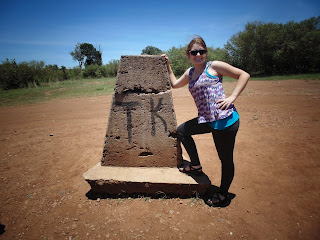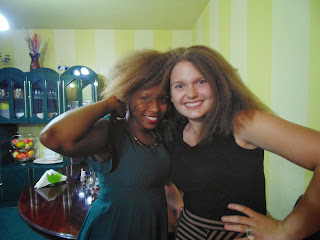This past weekend I got the opportunity to visit Masai Mara National Reserve on a three-day safari. Said to be the 8th Wonder of the World, and portrayed in various films and documentaries worldwide, Masai Mara, which runs into Serengeti National Park in Tanzania, is a huge game reserve in on the Kenyan-Tanzanian boarder. One of the few places in the world where you can see "The Big Five" (lions, black rhinos, elephants, buffalo, and leopards) all in one afternoon, Masai Mara is basically the quintessential safari experience.
Mara is the Maa word (the language spoken by the Masai people) for "spotted," which accurately describes the vast hilly landscape speckled with scrub brush, Acacia trees, tall grass, and the occasional sausage tree (click here if you want to find out what on earth a sausage tree is).
It was a good 7-hour drive from Nairobi to The Mara, longer than I had initially anticipated. We left early in the morning and arrived early afternoon. As we neared the reserve, the road became gravely and bumpy. Dust seemed to seep into all the cracks and crevices in the vehicle. By the time we arrived, I was eager to get out of the van and stretch!
We stayed in a safari camp just outside of the game reserve, as opposed to one of the significantly more expensive lodges located within. Our tent was comfortable, with two beds and an attached bathroom. There was limited electricity available during certain hours as well. Meals were provided for us in a common room that also boasted a small cash bar.
After eating a delicious lunch and taking a short nap, we headed out for an evening game drive.
 |
| A safari vehicle similar to ours, and the sun setting over the reserve |
To my surprise, the roof of the van we had driven to Masai Mara in was able to pop up, enabling us to stand in the back and take pictures without any interference. (If you're not entirely sure what I mean, click on the picture to the right to enlarge it)
Books and films always talk about how big the sky is in Africa. I didn't truly understand this until I visited Masai Mara. The skies were bright blue and expansive, dotted and swirled with clouds so
perfect I felt like someone had painted them.
More than once I found myself standing up at the back of our safari van, feeling the wind run through my hair, looking out at the landscape and wildlife surrounding me, thinking "I can't believe I live in such a beautiful world!" Yes, cheesy, I know.
 |
| An elephant baby and mother. |
On our first day out we saw hundreds of zebra, wildebeest, buffalo, and impala. We saw plenty of elephants and a few lions as well! We returned back to camp just as the sun was setting and shadows were settling on the hills. Not a single setting on my camera managed to capture the natural beauty of that moment--the sky was on fire!
By the time we ate dinner, and a had Tusker (one of the biggest East African beers) it was already time for bed. The electricity cut off at 10:00. My last few minutes before crawling into bed were spent outside, gazing at the stars. I am usually able to recognize at least the main constellations, like the big dipper, but I was completely disoriented by the immensity of the sky--I have never seen so many stars!
The next morning we woke up early for breakfast: eggs, toast, sausage and, of course, warm chai. Then I stumbled, still half asleep, into the van for a full day safari. You might think driving around watching wildlife could get boring, but it was far from it.
 |
| Wildebeest migrating from the Mara to the Serengeti |
During certain months hundred of thousands of Thompson's gazelle, zebra, and wildebeest migrate from the Masai Mara National Reserve south to Tanzania and The Serengeti. The Great Migration peak is during the month of July. The season ends in early October, so we were fortunate enough to catch the last few groups of migrating animals. We drove through herds of hundreds of wildebeest and zebra!
After making a stop at the boarder where Masai Mara National Reserve becomes Serengeti National Park in Tanzania for a picture, we headed towards the infamous Mara River, a necessary crossing point for the migrating herds. Since we were visiting the park near the end of the season, I didn't get to see any animals crossing. We did, however, see the hundreds of bodies of wildebeest that either been both trampled and drowned in the river. After lunch (not too far away from the wildebeest graveyard) we went on a brief guided river walk with a park ranger to see hippos and crocodiles.
 |
| Here I am, modeling at the boarder between Masai Mara Reserve in Kenya and Serengeti National Park in Tanzania |
 |
| Hundreds of wildebeest who did not make the crossing of the Mara River :( |
 |
| Look at that face! And those little stubby legs! Can you believe the hippo is one of the most dangerous animals on earth? |
There were several highlights of the second day's safari. For one, we saw a leopard. Leopards are rare, as they are quite elusive. We were able to get very close to this one, however. He was sleepy, lounging under a tree after a big meal. We also saw buzzards feeding upon a wildebeest carcass. Strangely, it was absolutely fascinating! One buzzard even fully crawled INTO the dead animal. But, perhaps the biggest highlight of the day was when several young male lions approached our vehicle! They were so close that I could have reached out the window and pet them like kittens.
We concluded our day with a visit to a nearby Masai village. In the face of the modern age, the Masai have managed to preserve their beautiful culture and heritage. We were shown around the community and given tours of their homes. Additionally, they showed us how to build a fire "the Masai way" and showed us some plants and leaves they use on a daily basis, including one used for toilet paper and another used to sand wood and clean your fingernails. They also sang a song traditionally sang after killing a lion for us!
 |
| Jumping with the Masai! Note: my awkward jumping face! |
Afterwards, we toured the local school where many Masai children attend classes. For me, it was just a glimpse of what the Masai life is. John, one of the Masai that I met, invited me back to stay and learn more about their language and culture (by the way, he has Facebook, something I was a little surprised to learn!) Maybe someday I will have the opportunity to return.
The next day we rose with the sun. Before we had even had breakfast, we were out for a game drive. What could we possibly see that we had not seen the day before? I wondered. But, I was wrong. Nature always has a surprise in store it would seem. That morning we got to watch lions devouring their breakfast--a recently killed wildebeest. Afterwards, we watched a few lions stalk their prey through the grass. It was remarkable to see them slink slowly across the land, as impala and water buffalo scattered.
All in all, my visit to Masai Mara was an experience, perhaps for a lifetime.
Alissa
 |
edit.
I have enabled the option to follow/subscribe to my blog! This feature can be found on the right hand side. I would love to get your feedback. Thanks :)






